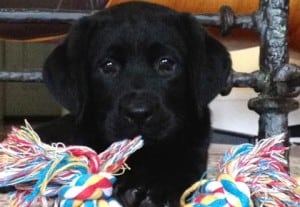
Today’s post is written by a now dear friend of ours, EML owner, veteran, and long-time dog trainer, Bud Roberts. We met Bud and Alice when they came to us looking for a black female puppy (Abbey, pictured above) after losing their prior Labrador love. They then adopted a retired mama from us (Hope, now Hopey, the yellow girl pictured) when she was about 4 years old. Both of these girls are now certified therapy dogs, though very different personalities. We love to hear Bud’s stories of these girls and the way they touch the hearts of those who desperately need some hope (see what I did there) and joy in their lives.
We consider Bud the dog whisperer really. He has worked with rescues and rehabilitated literally hundreds of dogs over the years. When it comes to behavioral issues and training advice, he is our top resource honestly.
Bud wrote the following on how to address resource guarding in regards to dog on dog resource guarding aggression, specifically. Dog training is often equally people training, so it’s important as the owner and trainer to pay attention to the details and be consistent. We hope many find this helpful!
 ~~~~~~~~~~~~~~~~~~~~~~~~~~~~~~~~~~~~~~~~~~~~~~~~~~~~~~~~~~~~
~~~~~~~~~~~~~~~~~~~~~~~~~~~~~~~~~~~~~~~~~~~~~~~~~~~~~~~~~~~~
Dog on dog aggression is complicated and it takes time and patience on your part to correct the offending dog. Here are some tips that I have used over the years in dog training and rehabilitation, about 40 years. This will not be an overnight quick fix, these are complicated souls and as I will point out below they are sending signals to each other constantly especially when in a situation where there could be an issue.
When testing this NEVER take the food away from either dog and as pointed out below, if removing something it’s a trade – “I am taking this, but you can have this”.
- No toys anywhere around the house for a while, no bones etc.
- Neither dog gets in anyone’s lap.
- Neither dog sleeps in any human bed
- Feed the dogs either in separate rooms or on opposite sides of the same room, we do this with our two EML’s, not for aggression, but if bowls are close they will rush thru their food and run over to the unfinished bowl and then both dogs are eating out of the same bowl. We trained to allow anything to happen to any toy and any food without their resistance or guarding. But, back to your already Resource Guarding Dog (RGD).
I would suggest trying these tricks: Both dogs on a leash, give the “good dog” (GD) a treat so the RGD can see it. When the RGD does nothing give him/her a treat and lots of praise. If the RGD reacts, growls, pulls or something I would simply say “that’s enough”, or something along those lines. What you are trying to do is get the RGD to think, “wonderful here is GD, and I am going to get Chicken whenever GD is around. You are trying to make RGD like to be around GD and not defensive. Without seeing the two dogs in action, all this could be precipitated by GD and RGD is reacting. Keep in mind that RGD is not bad, is not wrong, it’s just not desirable. Think of yourself, if someone comes over and appears or gives the signal or does take what is yours, you would be upset, and this is what RGD is doing. This is the assumption, IF they get along at all other times.
In addition, the RGD is giving signals that the GD is ignoring and you are missing in all probability. RGD will turn its head, the head turn will become a stare, they will eat faster, they will swallow before it’s done, they will brace their body, curl their lip, ears will go back, growl, bark, snap and finally bite. Look for the signals and if you pick up on them simply walk between the dogs. Your position can do much more than words. Keep in mind dogs don’t talk, everything they do is with body language. So, never take anything from RGD without trading with something much more desirable than they are guarding.
NEVER yell at either dog, no matter what and this is KEY. Keep calm. Failure to do so and you or whomever becomes the intimidator and demanding submission which is not the objective. The more the RGD does what they do, the more it will occur. With aggressive dogs, real aggressive dogs I usually whisper when talking to them or commanding them.
Couple of other places to start with the RGD and let the GD do as well:
Practice having them bring you things for a reward. Every time you take something, give something in return; a swap. Also, treat each dog as an individual as they are. If you give something to them, give it to GD first and then RGD with praise for not reacting similar to above.
Put things in front of RGD and teach them to wait, then you pick it up and give it to them with praise, they do not pick it up off the floor on their own, same with GD.
Dog on Dog is tougher than dog on human, it can be corrected but needs constant work.
Best of luck. Remember patience, calmness and continual – this is a corrective action on your part that is or will be constant until resolved.
Bud